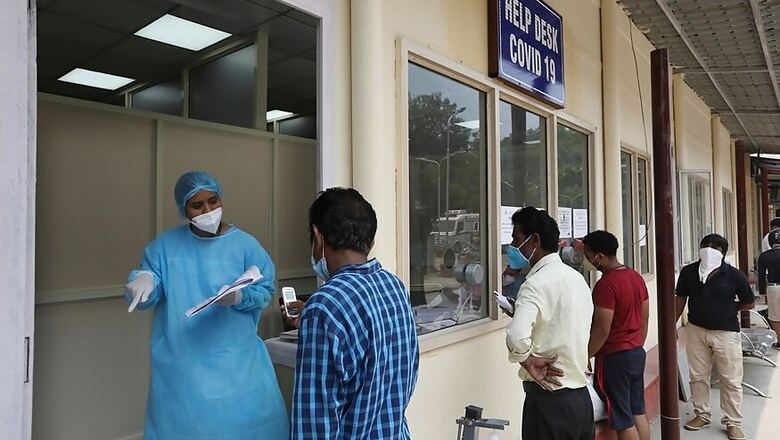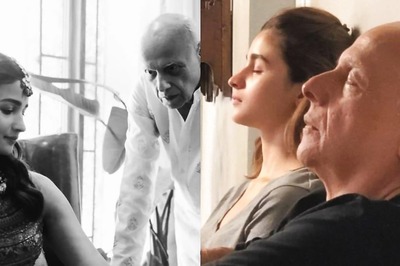
views
When the Covid-19 pandemic struck the national capital, it was Central Delhi that was hit the hardest, topping the list of 11 districts in terms of positive cases as well as fatalities. As the result of the serological survey revealed, the district has the highest exposure to the novel coronavirus (SARS-CoV-2 virus) with prevalence of 27.86% compared to the capital's overall 22.86%. Home to the Walled City, it is one of the most densely populated areas in the world. Now, close to three months later, the central district has a story of a remarkable turnaround — and is at ninth spot among Delhi's 11 districts.
Unlike the other parts of the capital, with tremendous pressure, the administration here had to hit the ground running, with aggressive strategies and thinking on its feet. The worst-affected subdivision was the Kotwali area which has the Walled City (Old Delhi or Dilli-6). The density of the population as well as the demography threw up unique challenges. District magistrate Nidhi Srivastava points out that Chandi Mahal is very different from Nabi Karim or Bapa Nagar. While Chandi Mahal is highly populated and residents may not be in the migrant category, Bapa Nagar was the area where the owners were less and the migrant population which was staying there as tenants was more, and Nabi Karim had a mix of both and also the market areas. "So these three areas, though in close proximity, are very different from each other," she says. "So we reached the conclusion that adopting different strategies for different areas would be beneficial."
In Daryaganj, for instance, macro as well as micro containment strategies, increased testing, contact tracing, strict monitoring of the Covid-19 positive cases in home isolation, and deployment of health workers who reached homes with pulse oximeters, much before the state government declared it a policy, paid off. This team of the Delhi government, the nodal officer, a civil defence volunteer and the sub-divisional magistrate (SDM) is making its way through crammed and dark stairways of a four-storey house to check on Covid-19 positive residents who are in home isolation.
A couple on the third floor are in home isolation since July 5: the worry is their two kids who, for now, have tested positive. The little distance between the houses on the same floor and the unplanned architecture which incidentally is the norm here makes it a tough job. The door of the house has been taped with yellow bands with 'Delhi Police' written on them in the form of an ‘X' touching the four corners, and a sticker, ‘Covid-19, Do Not Visit, Home Under Quarantine’, has also been stuck. The nodal officer hands over the phone number of the civil defence volunteer to the couple and now it is the volunteer’s responsibility to ensure that the household’s daily needs are met.
A brief conversation with the woman reveals that she is largely satisfied with the patient outreach though she has a complaint about the garbage not being collected every day. This same complex houses at least two families on each floor.
Devendar Kumar, who is a teacher with the Directorate of Education and is now a nodal officer, says, "We take a Delhi police person, civil defence volunteer, give a helpline number, give the number of the volunteer and whatever they need is provided by the volunteer." He and his team then move into the next house with a Covid-19 case. The same drill is followed in similar spaces. Samyak Jain has been in home isolation since June 27 and has moved to the one room on the third floor while his family lives on the ground floor. His house has also been taped and bears a sign pasted near the door. ‘’I have no symptoms, they come to take readings, I get calls," Jain says. The civil defence volunteer asks him whether he is washing his own utensils and if he needs anything, before moving on to the next stop.
When the rapid response team of the central district administration found that Chandi Mahal had 17 hotspots, and with Mumbai's Dharavi as an example, the administration decided to declare the entire area of four square kilometres with 100,000 people a containment zone, as containing 17 hotspots would be extremely difficult. It has been demarcated thus since June 6. Now, it has just two containment zones that still remain with approximately 200 people in them. Narrow lanes leading to even narrower byways, housing complexes on each side of the lanes appearing to be kissing each other, and large families living inside these houses: Chandi Mahal perhaps has layer upon layer of the old and the new seemingly held together by some invisible force. Policing, maintaining social distance, enforcing strict perimeter control and movement of health workers was difficult. But then, for the approximately one lakh people living under strict lockdown, it was not easy either. In the long run, the harsh lockdown has paid off.
Middle-aged Mehmood recalls, "Puri duniya mein hua lekin jitni sakhti yahan thi, kahin par bhi nahi thi. Prashasan ka kaha mana, musibat ata hai toh mukabala toh karna padta hai. Zameen par let toh nahi jayenge, eid ke din. Dusre Hindu tyohaar pe log andar hi rahe (This is a global pandemic, but the strictness of the restrictions here was unique. We listened to the administration, because when there's a problem one has to combat it. Can't just lie down on the ground on the day of Eid. During Hindu festivals, people stayed indoors)."
An officer of the Delhi government, Akhil, says, "There has been no spurt in cases after opening up. Maybe just a few. The situation is under control. The lockdown was successful."
Bapa Nagar, another unplanned and densely populated part of central district, was divided into three large containment zones and was demarcated on July 2. Here, of the 190 people who tested positive, 70 were pulled out and moved to Covid Care Centres as home isolation was simply not feasible with as many as 10 to 15 migrant residents sharing a room and community toilets. The moment the Covid-positive people were shifted out, Bapa Nagar saw a sharp fall in its case count. Now, just 8 active cases remain. Life is limping back to normal for elderly Vidya whose four adult children had tested positive. "Ye kya ho gaya, bachche bachenge ya nahi, mujhe bhi ho jayega toh kya karenge…dimag mein bahut tension tha. Lekin ab report negative aa gayi. Ab darr nahi lagta (What happened, will the kids survive, what if I get it too...there was a lot of tension in my mind. But now the report has come negative. Now I'm not afraid)."
Bapa Nagar is also the hub of small manufacturing units with business establishments married to residential complexes. One moment you might think that you are in the middle of a manufacturing complex with narrow push carts, their wheels grating on the pavement, as they are adeptly moved by labourers, and the next you are bang in the middle of rows of residences with clothes being dried and children playing. The yellow barricade is the only sign of a containment zone that is just a breath away from commercial complexes that function from basements, so cramped that lights have to be kept on in the afternoon also.
The Covid-19 threat notwithstanding, businesses are opening up. Dilshad Ansari, a shopkeeper, says, "Darr dimag mein basa hua hai, kahin hume bhi na ho jaye. Bach ke chalna padta hai. Jaldi chale jaate hain. Koi ata bhi nahi (There is perpetual fear in the mind, of getting infected. We have to be cautious at all times. We go back early. No one really comes anyway)." Meanwhile, three men are hard at work in a jeans manufacturing unit that operates out of a 4 x 6 feet room. And though they have their masks on, social distancing or "do gaj ki doori (a distance of two yards)" is impossible, and seems like a cruel joke. Since Bapa Nagar is also home to a fairly large percentage of migrant population, even after being demarcated, surveys are on by ASHA workers to check on occupancy of rooms. "Now we are doing surveys of 100 households each," an ASHA worker says. "Kitne kamre khali hain, kiraedaar hain ya nahi, ta ki jab ayenge pata rahega (How many rooms are vacant, if there are tenants, so that on arrival we'd be aware)."
Nabi Karim, with large market areas, was the first containment zone. Age and gender profiling by the central district administration showed that most of those affected were youth and fatalities were low. "So here, we had three shades of containment zones: a big containment zone, micro containment zones and, when there were isolated cases, taping of the houses was done," Nidhi Srivastava says.
"People resisted, saying why they were targeted. But the ASHA workers performed very well," SDM Ankur says. "There have been no positive cases in the past 10 to 15 days, because of the strong network of ASHA workers on the ground. Every third or fourth day, they check a house. Any news of a case and we took action immediately. Because of that people became aware." Indeed, winning the trust of a largely apprehensive people was not easy. The initial attempts of the teams were met with sullen silence and non-cooperation as the fear was that the surveys were for some other purpose, maybe the Citizenship Amendment Act (CAA) or the National Register of Citizens (NRC), as nobody had really heard of Covid-19 then.
Mobile testing vans that reached narrow lanes and remained parked in those with teams of technical and health workers, loudspeakers blaring messages to be cautious, asking people to come forward for testing, reaching out to community leaders, etc, paid off, but not before a month had passed. A Nabi Karim resident, Mohamad, recalls, "Bohut pabandiyan thi, bimari thi, khaane-peene ki pareshani thi, karkhane band the, police ne cooperate kiya, patrolling thi (There were a lot of restrictions, sickness, scarcity of food and water, factories were closed, the police cooperated, there was patrolling)."
Central district also saw a large number of fatalities. One of the reasons was that for the first couple of months people were not forthcoming about the disease until it was too late and there was inability to reach hospital in the ‘golden hour’. Ambulances were put at the disposal of the district administration and various areas were linked to hospitals so that once the patient reached the medical centre, a team was ready to take care of formalities. Dedicated teams of three with mobile numbers and dedicated vehicles were provided, carrying out pulse oximetry tests on people much before it was rolled out by the state government, and this team was the first point of contact. The vulnerable age was reduced to fifty-plus compared to sixty-plus for the rest of Delhi in this district after it was noticed that deaths were also occurring among those above fifty. With reports coming to the DM, the SDM and the nodal officer, anyone with oxygen level below 90 was pulled out and moved to a hospital. Daily meetings of all stakeholders including doctors at 5pm helped reinvent strategies as well as work as a team.
The brick-red sprawling private school right next to the district magistrate's office has been requisitioned and functions as a rapid testing centre, district surveillance unit as well as telemedicine hub. Aarti, a civil defence volunteer, and Sumit, a government schoolteacher, are hard at work, making calls to Covid-positive persons in home isolation to check on their health.
"Incoming calls are about 5 to 6 per volunteer but we have to do outgoing calls according to data," Aarti says. "We have to make 50 calls per volunteer, and, in case of severe symptoms, make them speak to the doctor."
Sumit adds, "We talk to the person: if there are any symptoms, any fever, whether in quarantine or not, if symptomatic, whether admitted or whether help is needed. We report serious cases to the SDM and then an ambulance is sent to pick up a patient to head to the hospital. This system is successful as people feel that the government cares for them."
A doctor, Roshan Jodhkaur, has been attending to patients on the telephone. "We get calls from mildly symptomatic patients and also from family members who want to be tested," he says. "We tell them testing ke liye mana nahi hai, sab ke liye han hai (There's no bar on testing, anyone can avail it). It would be ideal to meet people but with so many patients this is also fine. Patients are saved from long queues."
Being the worst-hit district, Central Delhi always scored high in terms of testing: 21,000 per million. Now, mobile testing vans, with doctors, lab technicians and health workers move to each nook and cranny, motivating people to turn up for tests.
At Anna Nagar, a slum cluster, the response is robust. A doctor, a lab technician and a couple of ASHA workers form the ground team. Lab technician Vashist, all wrapped up in a PPE kit, says, "We collected 170 samples today. Yesterday it was 350. Before that it was 70. There is good public response. Results come within 30 minutes while people wait here. Positives come after 15 minutes." He also says that those like him take the biggest risk, and, going through a difficult time, they get dehydrated also. But it is their duty to turn up. And that he has been turning up, being on the field since March.
Dr Sunil Minz explains, "After testing positive, if they fulfil the required criteria, then home isolation is recommended. Else they are sent to Covid Care Centres. And when they test negative, if asymptomatic, no test, but if symptomatic, they are advised RT-PCR."
If the central district in Delhi can fight back the Covid-19 threat, every place in this world has hope. Maybe it will take some time before tourists return to the Red Fort, before pilgrims flock again to the Jama Masjid, before Chandni Chowk bustles with abandon again. But while people struggle with masked faces, in crammed spaces, to learn to live with Covid-19, they too have a lesson to offer to the world in fending off the pandemic.

















Comments
0 comment